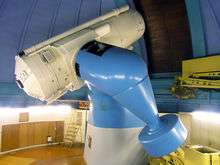Astronomical Institute of Czech Academy of Sciences

The Astronomical Institute of the Czech Academy of Sciences[1] was founded in 1954. Currently, it has its headquarters in Ondřejov observatory, roughly 35 km south-east from Prague and its director is Vladimír Karas.
Field of research and organization of the institute
The institute is focused on stellar, solar and galactic astronomy, research of meteors and motion of cosmic bodies. It has about 157 permanent employees (status on 31.12.2005) of which roughly 80 percent works in Ondřejov. It is divided into the following departments:
Department of Solar Physics

Regions of solar eruptions are studied mainly in this department. For the observations are used optical telescopes and radiotelescopes. The head of the department is František Fárník.
Department of Interplanetary Matter
Meteors, comets and asteroids are the main research targets of this department. The meteors are observed by optical telescopes and a meteoric radar. For the photometric observations of asteroids, the department uses 65 cm optical telescope. The head of the department is Pavel Spurný.
Stellar Physics Department
This department is focused on research of stars. It focuses mainly on studies of hot stars (class Be), models of stellar atmospheres, dynamics of stellar winds and relativistic astrophysics. For this purpose uses the department the biggest telescope in Czech Republic - reflector with a 2m wide mirror. The head of the department is Jiří Kubát.
- Under this department belongs nowadays also a working Group of Astrophysics of High Energies under the leadership of René Hudec. It deals with a research of gamma and roentgen radiation in the Universe, which we can observe in gamma bursts or blazars.
Galaxies and planetary systems department
This department is located in Prague. It deals mainly with a research of effects of solar system on the Earth. The head of the department is Jan Palouš.
- The department also contains a Group of Dynamics of Space Satellites, which deals with theoretical and practical studies of motion of space satellites. Its main research project was the micro-accelerometer Macek for measurements of accelerations of non-gravitational origin. Macek was released in the year 1996 on the space shuttle Atlantis (mission STS-79) and in the year 2003 on the Czech satellite MIMOSA.
History of the Institute

The Astronomical Institute is a direct descendant of an observatory founded at the beginning of 18th century by Jesuits in the Old town of Prague. After the first world war, the observatory has become a state observatory. In meantime, there was another observatory being built by Josef Jan Frič in Ondřejov which he donate to the Czech state in 1928. At the foundation of the Czechoslovak Academy of Sciences were these two observatories merged into one institution under the name Astronomical institute of Czechoslovak Academy of Sciences. Its first director was Dr. B. Šternberg.
See also
- Astronomical Institute of Slovak Academy of Sciences
- Department of theoretical physics and astrophysics of Masaryk University
- Institute of physics of the University of Pavol Jozef Šafárik
References
- ↑ "The official website of the institute". Retrieved 2009-09-08.
External links
 Media related to Ondřejov Observatory at Wikimedia Commons (includes media related to Astronomical Institute)
Media related to Ondřejov Observatory at Wikimedia Commons (includes media related to Astronomical Institute)- The official website of the institute
Coordinates: 49°54′32.98″N 14°46′54.8″E / 49.9091611°N 14.781889°E